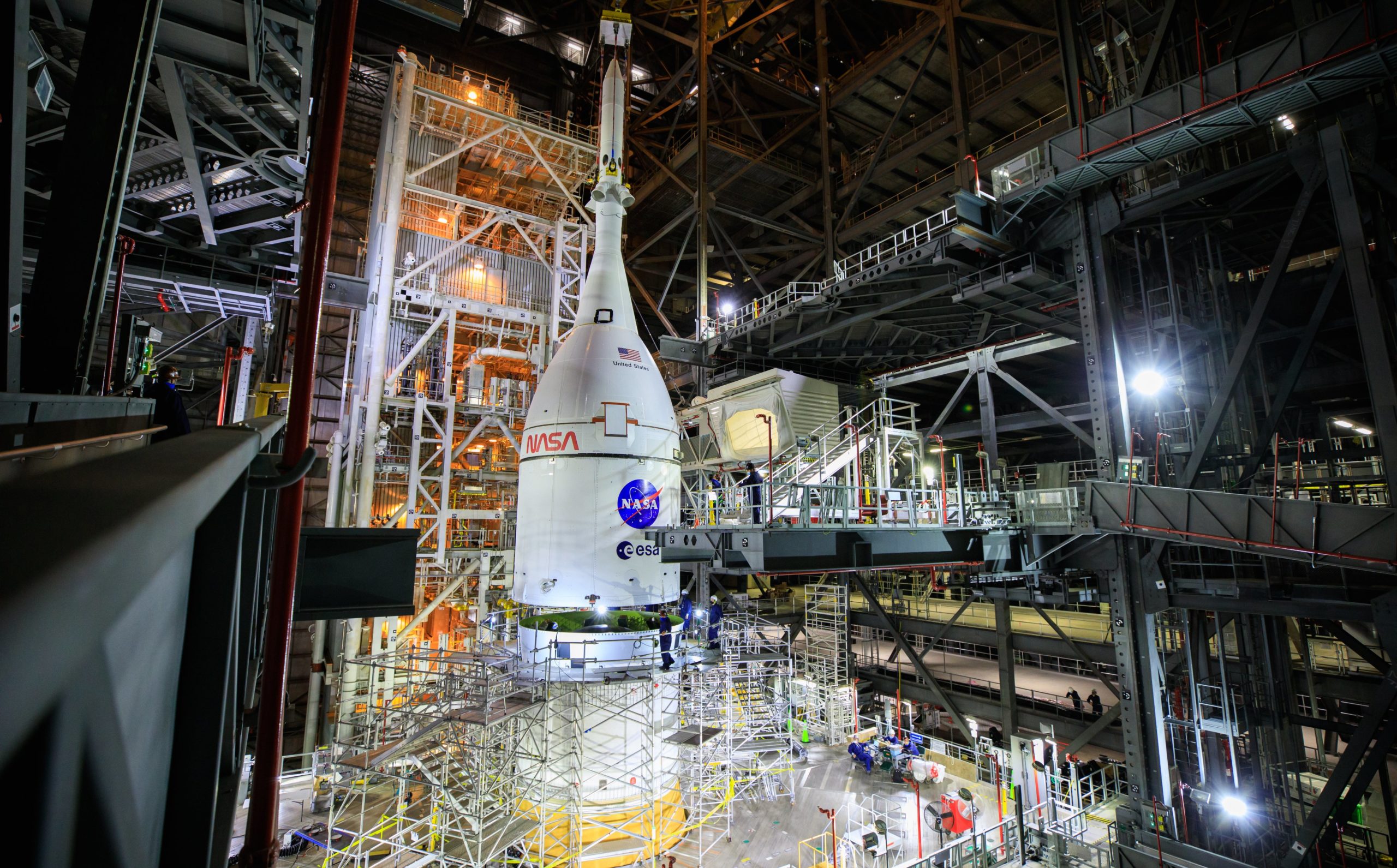
For SpaceUpClose.com & RocketSTEM
CAPE CANAVERAL, FL – Marking a major milestone towards returning American astronauts to the Moon this decade NASA finally completed stacking of the agency’s maiden Space Launch System (SLS) megarocket and Orion spacecraft on Oct. 21, for the Artemis I uncrewed mission around the Moon and is targeting launch February 2022 from Florida’s Spaceport – if all goes well with numerous upcoming preparatory operations as it enters the final phase of testing before launch.
Technicians have been methodically conducting the SLS stacking and integration operations with Orion inside the iconic Vehicle Assembly Building (VAB) at NASA’s Kennedy Space Center (KSC) in Florida which were completed on Oct. 21, 2021.
NASA officials announced completion of SLS stacking activities and confirmed that Feb. 12, 2022 is the earliest that Artemis 1 can lift off, at a media briefing held on Oct. 22.
The integrated SLS Orion stack for Artemis 1 stands a mammoth 322 feet tall (98 meters) inside the VAB High Bay 3 at NASA Kennedy.
“With stacking and integration of NASA’s Space Launch System rocket and Orion spacecraft complete, we’re getting closer and closer to embarking on a new era of human deep space exploration,” said NASA Administrator Bill Nelson.
“Thanks to the team’s hard work designing, manufacturing, testing, and now completing assembly of NASA’s new rocket and spacecraft, we’re in the home stretch of preparations for the first launch on the Artemis I mission, paving the way to explore the Moon, Mars, and beyond for many years to come.”
😍 What a view! 😍
NASA has completed stacking of the agency's Space Launch System rocket and @NASA_Orion for the @NASAArtemis I uncrewed mission around the @NASAMoon.
READ MORE HERE >>> https://t.co/BdYhoU5G32 pic.twitter.com/dB64inIm8U
— NASA_SLS (@NASA_SLS) October 22, 2021
“NASA’s Orion spacecraft is secured atop the agency’s powerful Space Launch System rocket, and the integrated system is entering the final phase of preparations for an upcoming uncrewed flight test around the Moon,” NASA officials stated.
“With stacking complete, a series of integrated tests now sit between the mega-Moon rocket and targeted liftoff for deep space in February 2022.”
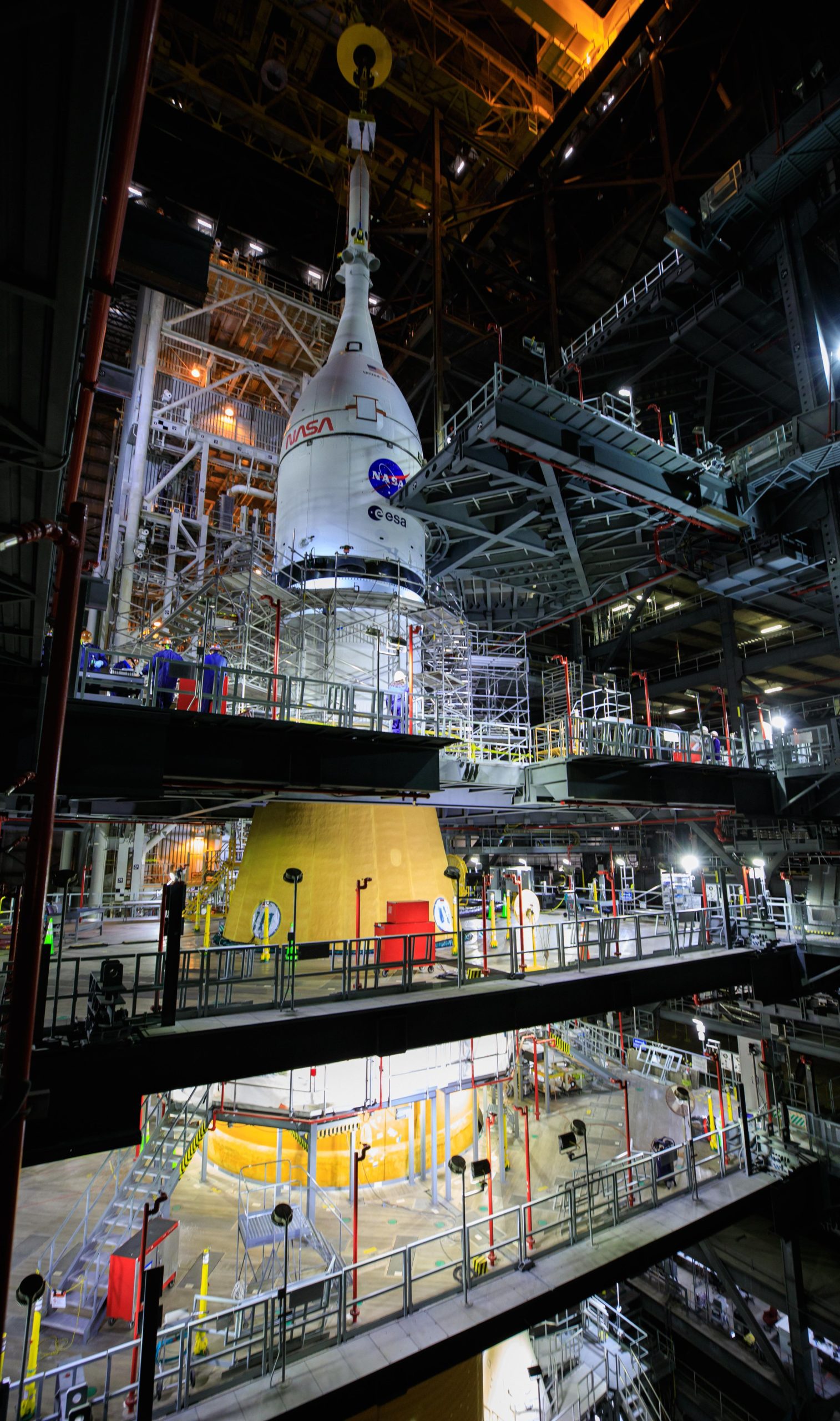
The Artemis I mission will pave the way for a future flight test on the Artemis 2 mission in later 2023 with crew of four astronauts from the NASA and Canada, the next human lunar landing on the Artemis 3 mission planned for no earlier than late 2024 – that NASA hopes to establish starting a regular cadence of more complex missions with astronauts on and around the Moon under Artemis.
On the Artemis 3 mission NASA plans to land the first woman and very likely the first person of color on the surface of the Moon.
With the final stacking of @NASA_Orion and @NASA_SLS complete, we have assembled the largest rocket at @NASAKennedy since the Apollo era. A huge congrats to the Orion, SLS, and @NASAGroundSys teams that made this significant #Artemis milestone possible! https://t.co/gu5vUa2f5w pic.twitter.com/HWDtPCXrzt
— Jim Free (@JimFree) October 22, 2021
“It’s hard to put into words what this milestone means, not only to us here at Exploration Ground Systems, but to all the incredibly talented people who have worked so hard to help us get to this point,” said Mike Bolger, Exploration Ground Systems program manager.
“Our team has demonstrated tremendous dedication preparing for the launch of Artemis I. While there is still work to be done to get to launch, with continued integrated tests and Wet Dress Rehearsal, seeing the fully stacked SLS is certainly a reward for all of us.”
Watch this cool NASA time lapse of the Orion stacking on SLS:
Time lapse footage of the @NASA_Orion stacking is here! 👀
Watch as teams at @NASAKennedy make history with the addition of the spacecraft atop the @NASA_SLS rocket, completing assembly for @NASAArtemis I. pic.twitter.com/pG7ePSE9Wb— NASA's Exploration Ground Systems (@NASAGroundSys) October 22, 2021
SLS is the most powerful rocket the world has ever seen generating some 8.8 million pounds of liftoff thrust at ignition – about 15% more powerful than NASA’s legendary Saturn V that hurled the first humans to land on the Moon back in 1969 on the Apollo 11 moon landing mission.
Engineers and technicians with NASA’s Exploration Ground Systems (EGS) and Jacobs attached the Orion spacecraft to one of the five overhead cranes inside the VAB and began lifting it a little after midnight EDT Oct. 20.
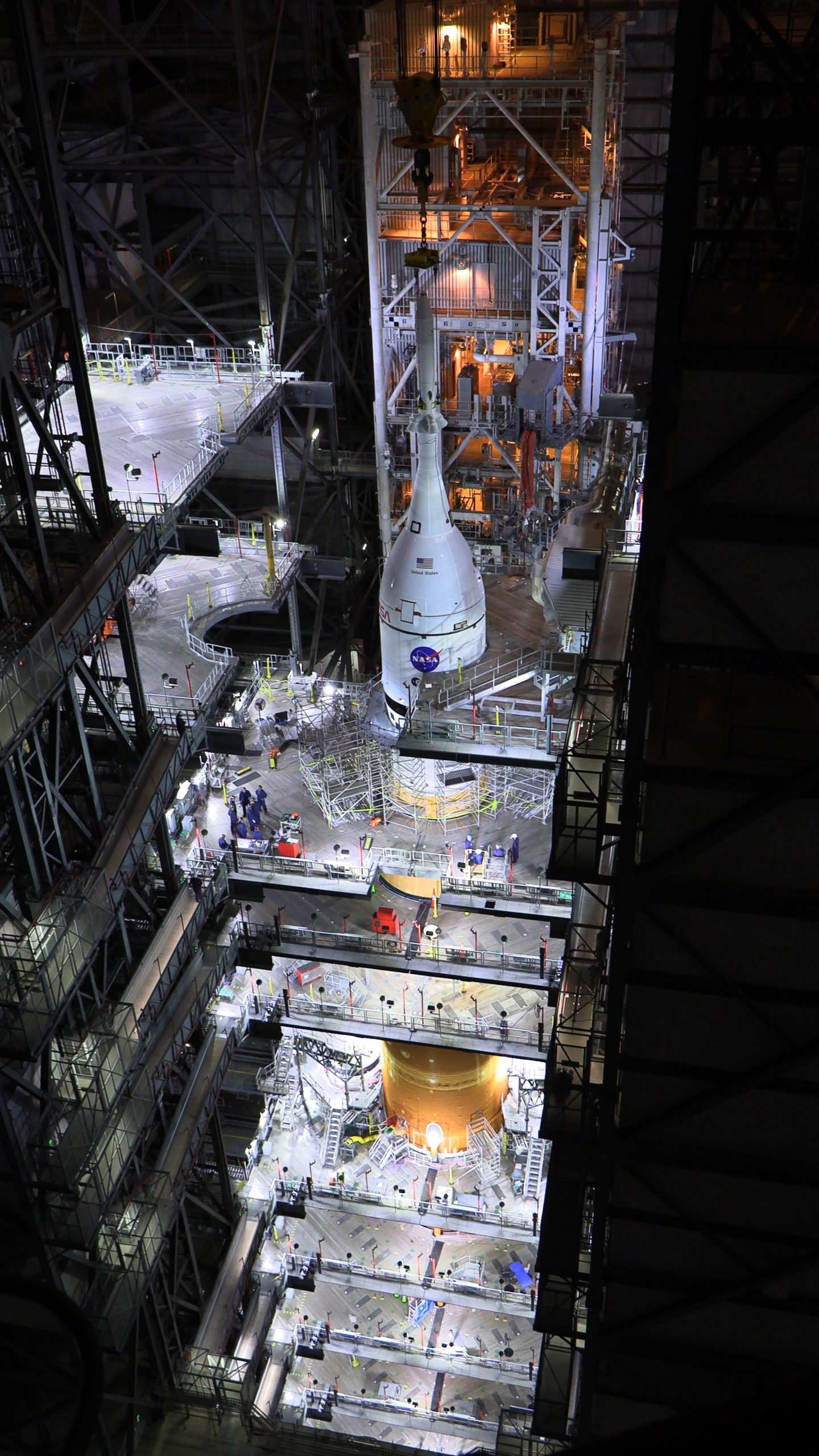
Next the team slowly lowered it onto the fully stacked SLS rocket and connected it to the waiting Orion Stage Adapter.
This required the EGS team to align the spacecraft perfectly with the adapter before gently attaching the two together.
Overall the Orion stacking operation took several hours to make sure Orion was securely in place.
The stack is complete! ✅
Next up, @NASAGroundSys teams will conduct integrated tests of @NASA_Orion and Space Launch System (SLS) along with the ground equipment, prior to rolling the rocket and spacecraft to the launch pad for a final test, known as the wet dress rehearsal. pic.twitter.com/q3639Fs84C
— NASA_SLS (@NASA_SLS) October 22, 2021
Here are more cool NASA photos of the final Orion SLS stacking operations:
More photos showing the @NASA_Orion spacecraft for the @NASAArtemis I mission, fully assembled with its launch abort system, being lowered on top of the @NASA_SLS rocket in High Bay 3 of the Vehicle Assembly Building at @NASAKennedy in Florida on Oct. 20, 2021. pic.twitter.com/uogRdFac8H
— NASA's Exploration Ground Systems (@NASAGroundSys) October 21, 2021
And more amazing NASA video footage of Orion stacking:
😲 Check out this amazing footage.
The @NASA_Orion spacecraft for the @NASAArtemis I mission is lifted & lowered onto the @NASA_SLS rocket inside the VAB at @NASAKennedy. Work is currently underway to fully secure the spacecraft to the rocket.
Full Video: https://t.co/aJvuZsfVJY pic.twitter.com/I99XUD3CRE— NASA's Exploration Ground Systems (@NASAGroundSys) October 21, 2021
NASA’s Orion spacecraft was moved on Oct. 18 to the VAB for stacking on top of SLS,
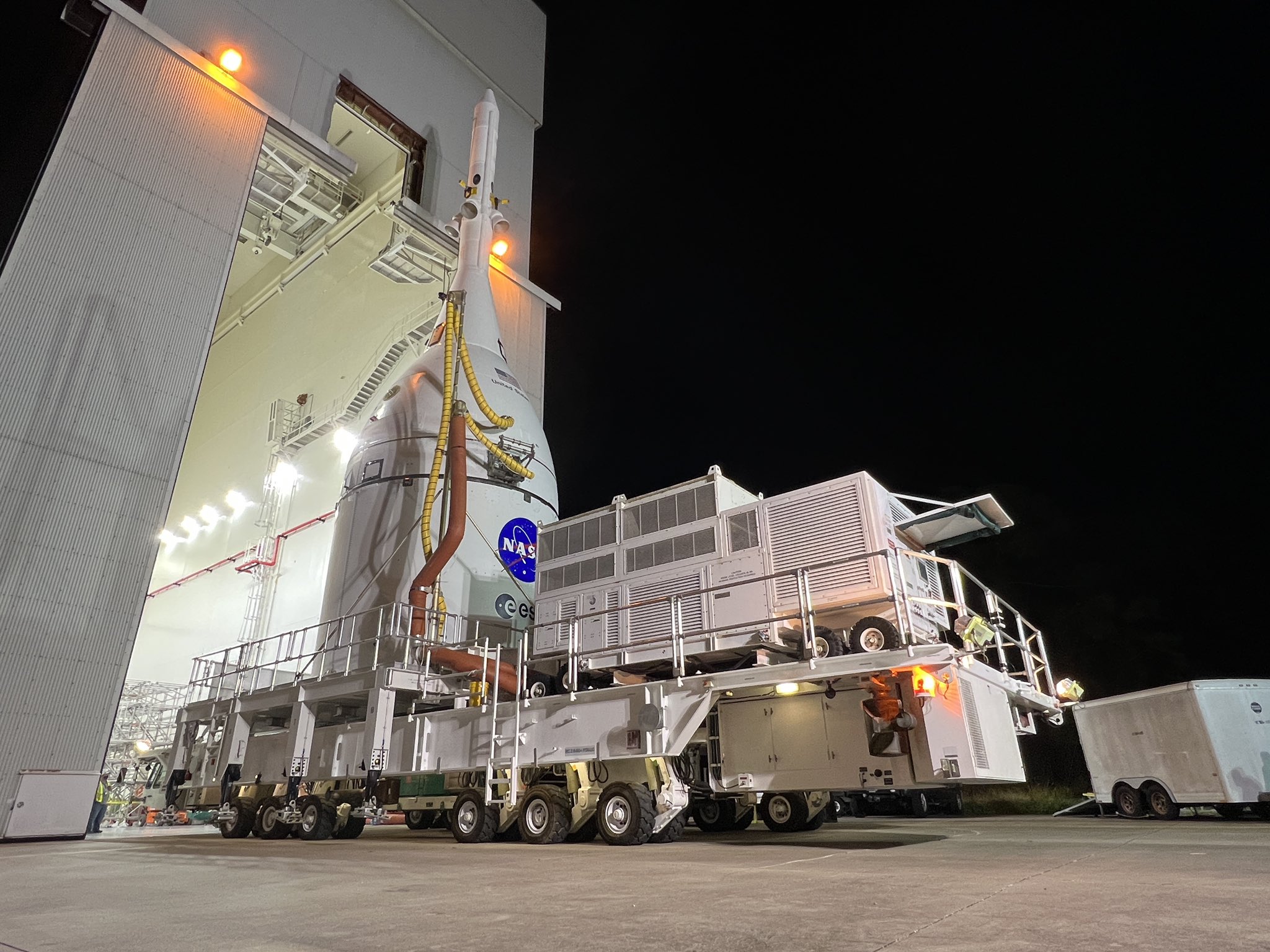
Orion’s move started Monday evening, Oct. 18 exiting the Launch Abort System Facility (LASF) around 6 p.m. EDT standing upright and gloriously exposed atop a mobile transporter – sporting the energetic logo ‘We Are Going’ – and was completed overnight Tuesday early morning, Oct. 19 with arrival at the VAB around 5 a.m. EDT.
This first SLS core stage arrived on NASA’s Pegasus barge April 27 and was then rolled off the barge and into VAB two days later on April 29 for the extensive stacking and preparatory operations for launch on the history making Artemis 1 mission to deliver NASA’s Orion deep space human rated capsule to the Moon.


The overall stacking process began on June 11 when technicians with NASA’s Exploration Ground Systems team lifted the 21 story core stage by first hoisting it horizontal off the transporter inside the VAB transfer aisle and then rotated it vertical.

This graphic illustrates the Artemis 1 mission:
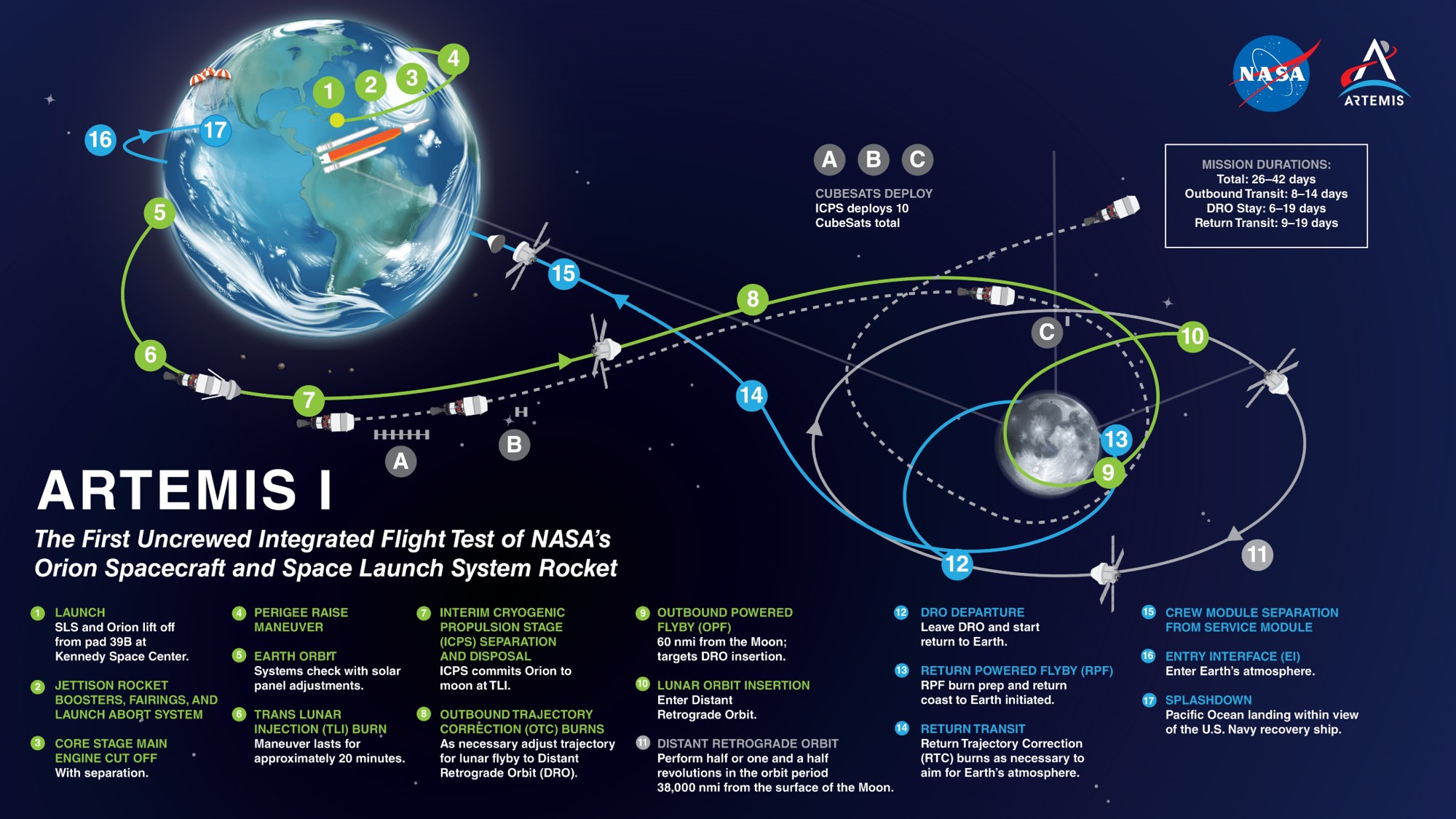
This NASA graphic illustrates the stacking process.
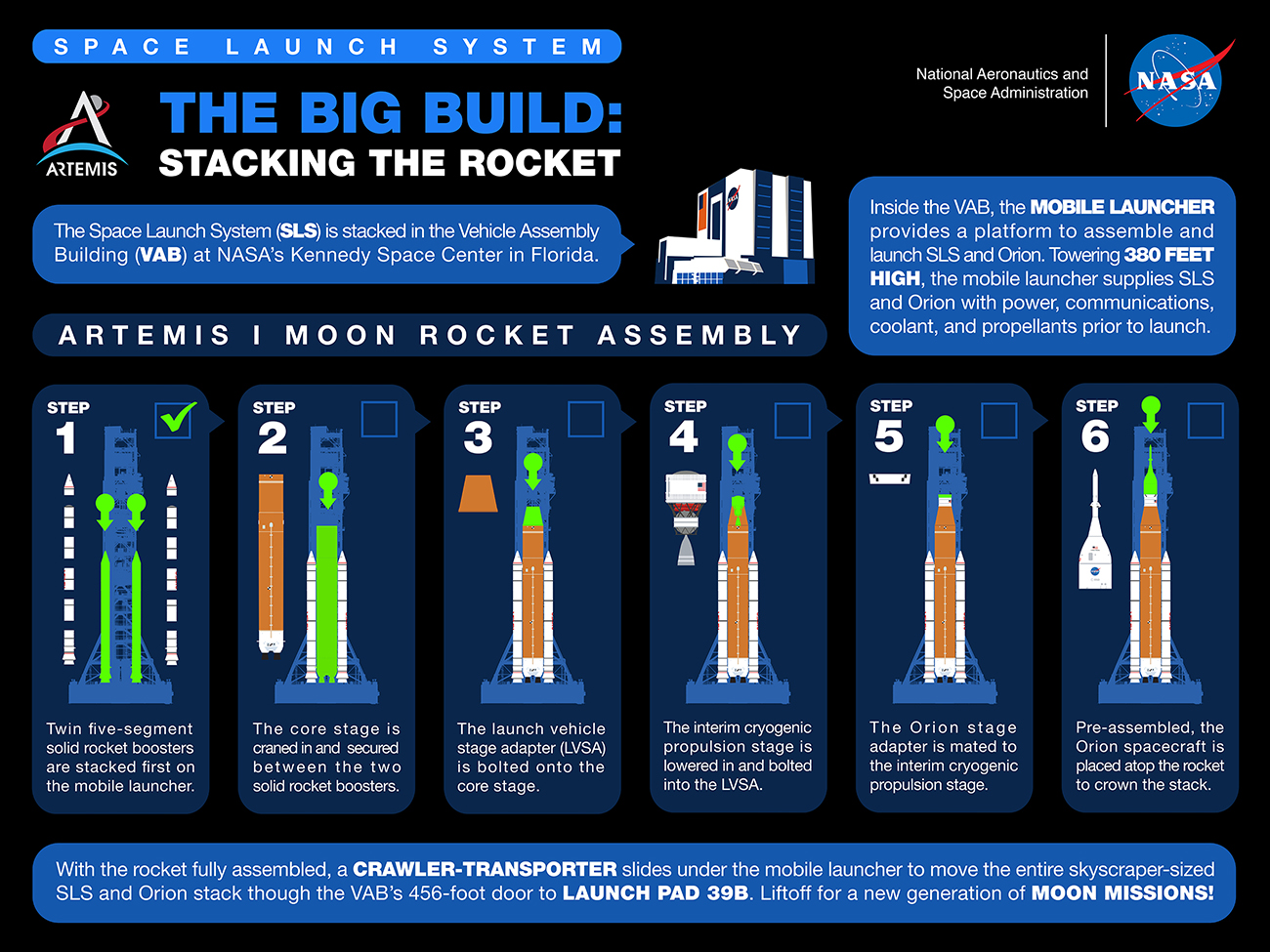
Lockheed Martin is the spacecraft’s prime contractor, and ESA (European Space Agency) oversees the development of Orion’s service module.
The Artemis 1 Orion crew capsule was manufactured inside NASA’s Neil Armstrong Operations and Checkout Building (O & C) at KSC.
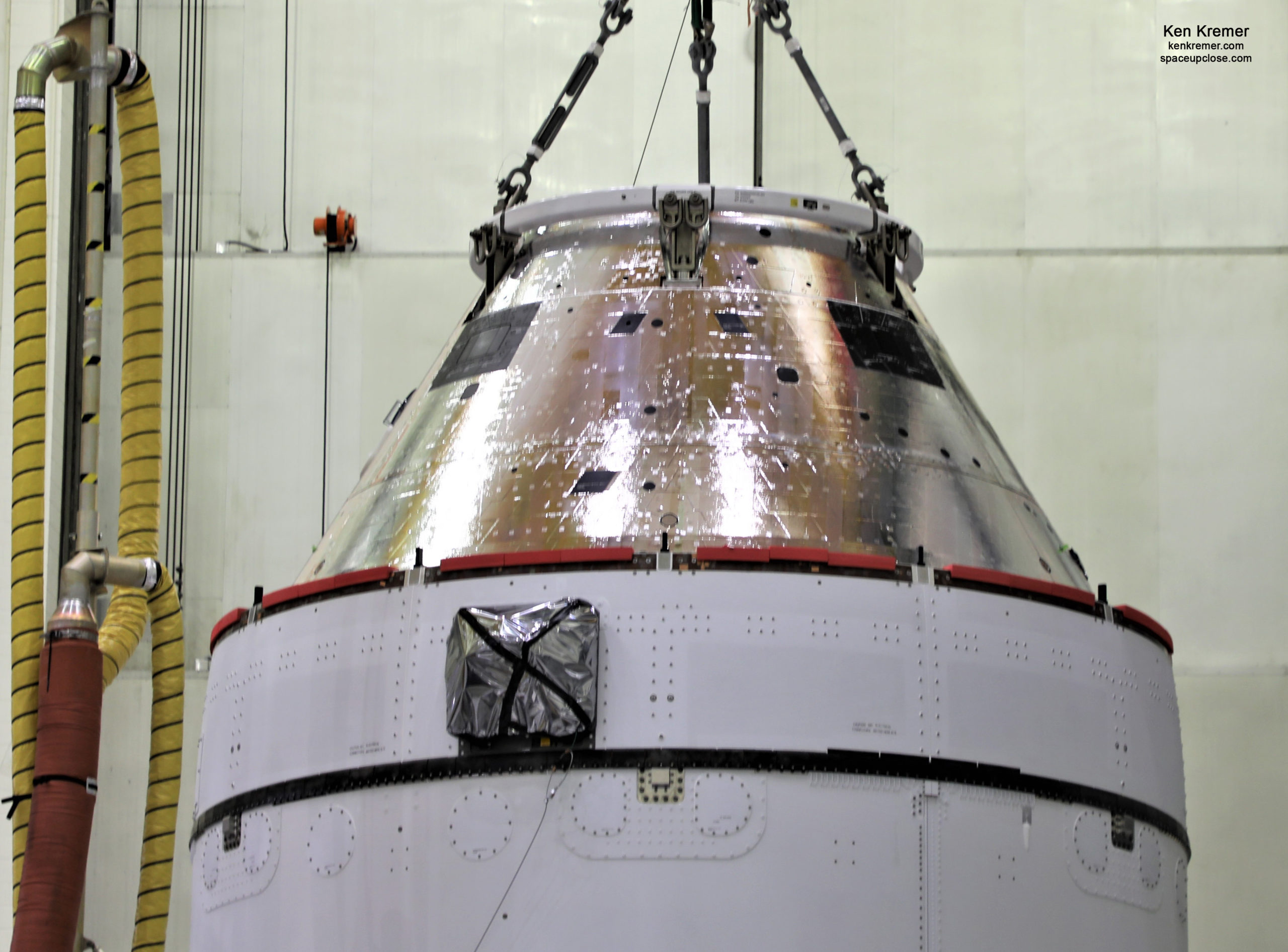
Media including Ken Kremer and Jean Wright for Space UpClose were invited for an up close visit to see and photograph Orion after assembly of the NASA Crew Module & ESA Service Module was completed inside the O & C earlier this year in January 2021.
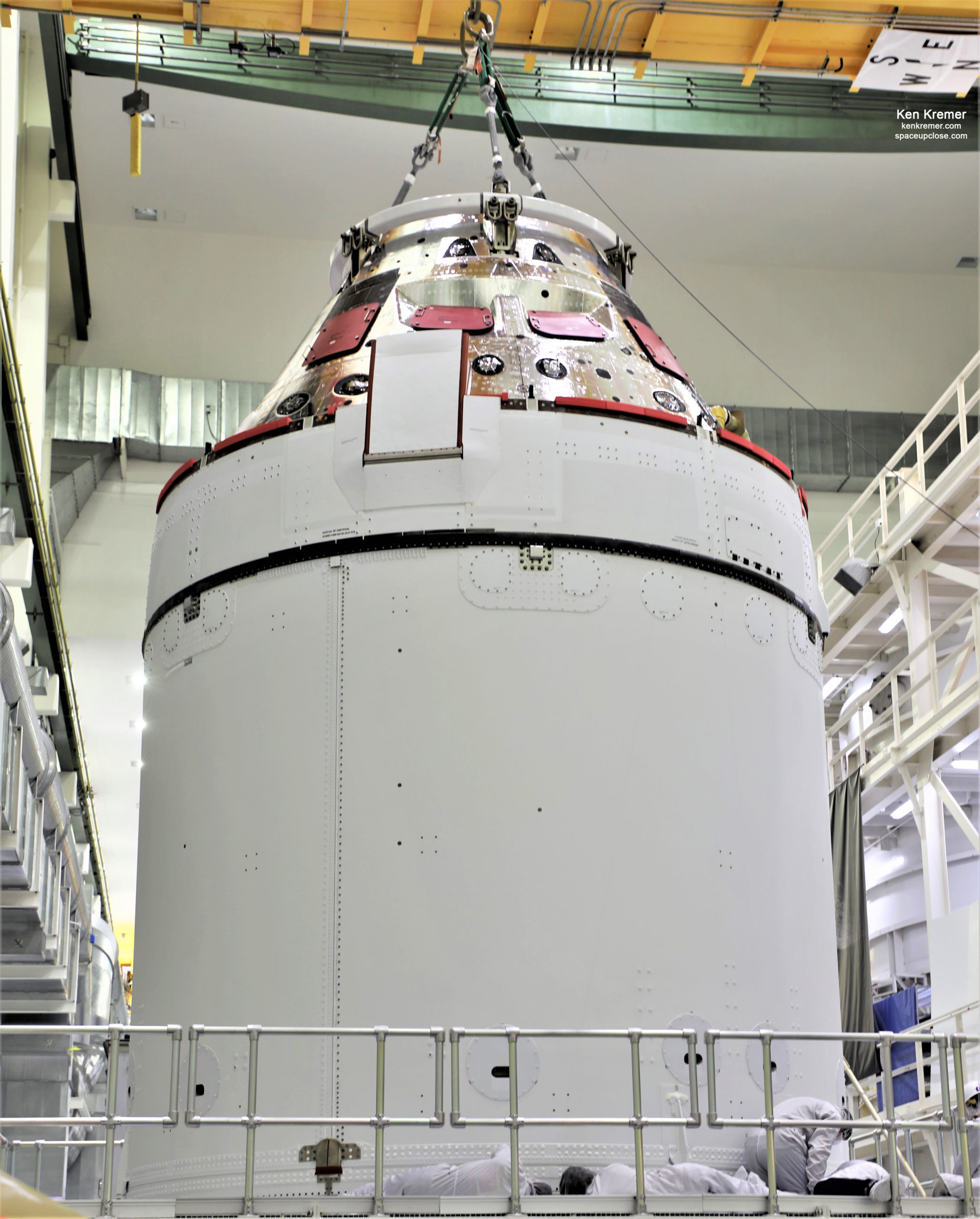
The next steps are NASA’s Exploration Ground Systems teams will conduct integrated tests of Orion and SLS along with the ground equipment, prior to rolling the rocket and spacecraft to the launch pad for a final test, known as the wet dress rehearsal. This final test will run the rocket and launch team through operations to load propellant into the fuel tanks and conduct a full launch countdown.
Following a successful rehearsal, NASA will roll the stack back into the VAB for final checks and set a target date for launch – tentatively Feb 12 at this point.
Watch Ken’s continuing reports about Artemis, SLS, Orion and NASA missions, Lucy Asteroid mission, Blue Origin and Space Tourism, SpaceX Cargo and Crew Dragons, SpaceX Starlink, Commercial Crew and Starliner and Crew Dragon and onsite for live reporting of upcoming and recent SpaceX and ULA launches including Crew 1 & 2 & 3, ISS, Solar Orbiter, Mars 2020 Perseverance and Curiosity rovers, NRO spysats and national security missions and more at the Kennedy Space Center and Cape Canaveral Space Force Station.
Stay tuned here for Ken’s continuing Earth and Planetary science and human spaceflight news: www.kenkremer.com –www.spaceupclose.com – twitter @ken_kremer – email: ken at kenkremer.com
Dr. Kremer is a research scientist and journalist based in the KSC area, active in outreach and interviewed regularly on TV and radio about space topics.
………….
Ken’s photos are for sale and he is available for lectures and outreach events
Please consider supporting Ken’s work by purchasing his photos and/or donating at Patreon:
https://www.patreon.com/kenkremer
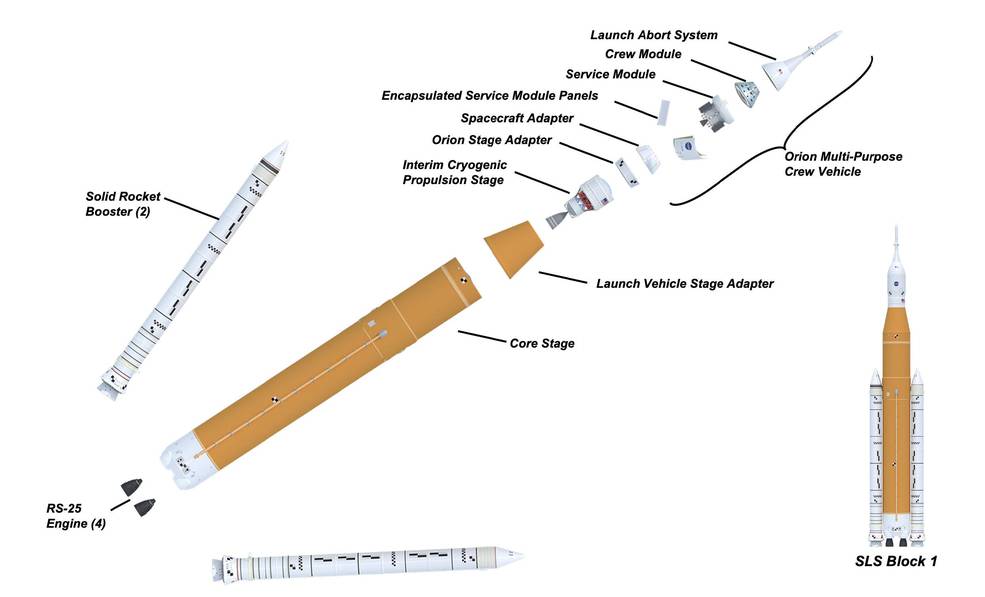


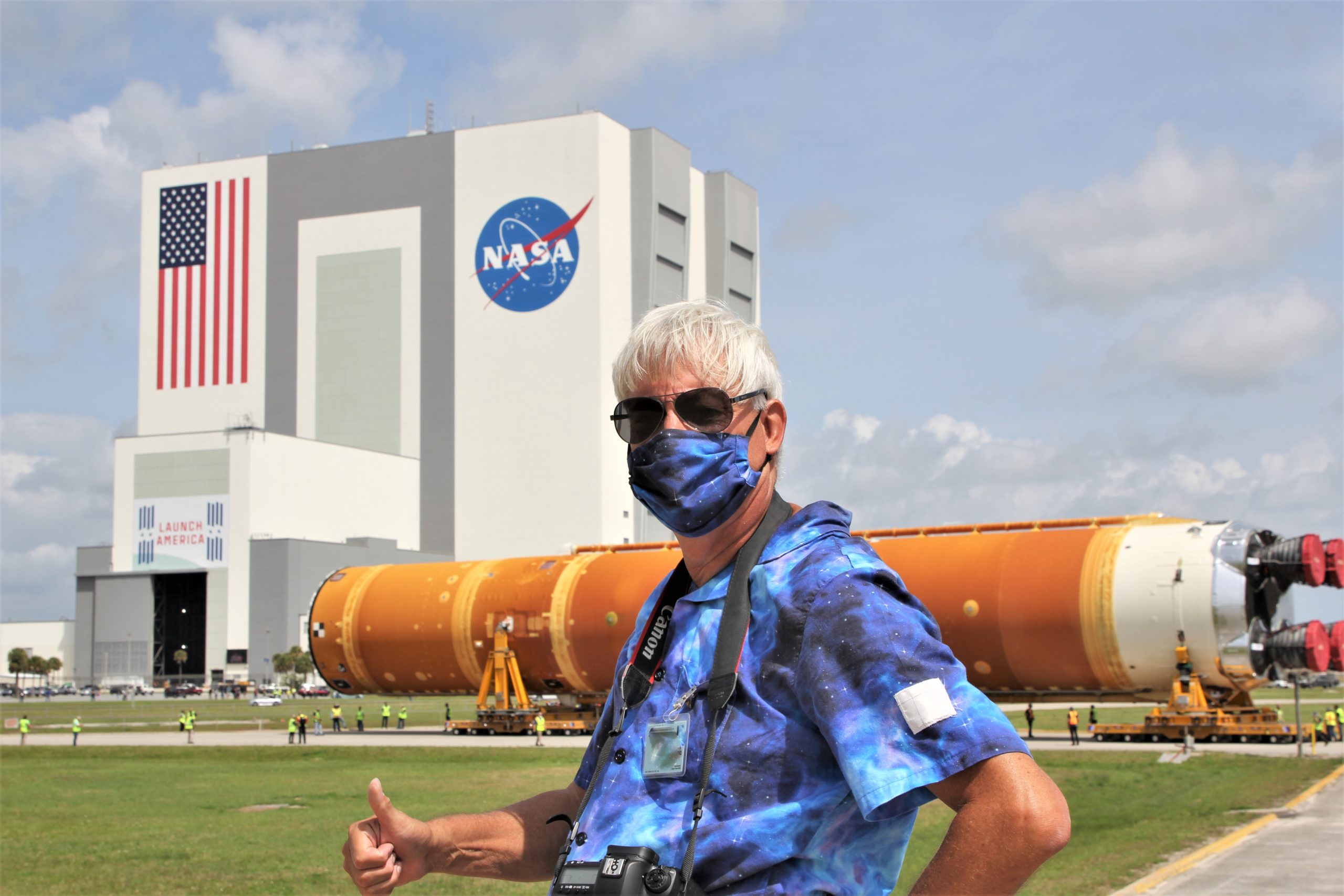
x



